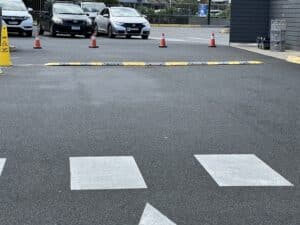

‘Street Shopping Centres’ refers to any open, street-facing shopping area. It differs from a conventional shopping mall in such that all shops are accessible directly from the parking area or main road. Whether the shops are positioned directly on the main walkway, or in a constructed U-shape or L-shape design, all types of street shopping areas pose a large number of safety concerns.
Pedestrians
Pedestrians are usually provided with an informal pathway that links the parking area to the shop fronts, however, pedestrians are also allowed to freely meander between vehicles – both parked and driving – in order to gain access to the shops via the shortest route. Typically, this casual location means that most pedestrians do not apply the same level of caution that they would on main motorways and dual-lane roads. Pedestrians can often be seen trying to manoeuvre an overloaded trolley, while simultaneously trying to coordinate several excited toddlers. This scenario may sound comical, but it is a major safety hazard for all concerned. The parent’s primary focus is on steering the trolley; their secondary focus is the dispersed children. This places them and the children at risk of being injured by a driver whose primary focus is finding an available parking bay.
Speed limit
Generally, there are no designated speed limits within these areas, especially in U-shaped or L-shaped centres where the parking area is separated from the main road. The entrance to these centres flows directly in from the main road intersection. So for example, if a motorist is travelling at 60kph and takes a slip route to enter the shopping centre, he/she is unlikely to reduce his speed down to 5kph while entering the centre as he/she is still in a main driving area for more than 50 metres before reaching the designated parking area. Any pedestrians will be caught unaware and be severely injured. Other vehicles that are exiting the centre are also at risk of collisions as a speeding driver is less likely to perform a complete stop at the approaching intersection.
Road rules
Most street centres do not have adequate road signage. The lanes are not clearly demarcated and the small intersections do not clearly indicate right of way, or have sufficient road safety signage. Many of these centres have long lengths between each intersection, resulting in the acceleration of speed before the next intersection is reached. Any unsuspecting pedestrians that are then walking through the parked cars are not visible to motorists and therefore face an increased risk of injury during any part of these lengths. Street centres do not abide by a strict set of road safety rules that need to be adhered to. It may not seem relevant in areas that are detached from the main road, but this is one of the main reasons why street shopping centres have an unusually high incident rate. Pedestrians and motorists are left to their own devices, and can adapt or disregard any road rules as preferred.
Traffic congestion
During peak shopping hours, street centres are unable to accommodate the increased volume of vehicles. This leads to impatient motorists who further disregard general road etiquette. Several surveys have noted that peak shopping hours have the highest number of recorded vehicle collisions.
The increased number of incidents has prompted many centres to re-evaluate their road safety strategies. Many centres have ensured that lanes and intersections are clearly demarcated; that speed limits are clearly indicated; and that traffic calming measures such as speed humps are being fitted. The installation of speed humps has proved to be a very effective solution in many centres throughout Australia.
Centres are actively working towards improving the safety of their shoppers, but it is not solely their responsibility. Motorists and pedestrians need to also be aware of the risks and apply caution when visiting any street shopping centre. If we all work together, we can ensure a safe, enjoyable shopping experience for everyone.



For 10 years, our focus has been on one thing: to provide one style of product and to do it well.
Our wheel stops, speed humps and rumble bars meet Australian Standards, don’t fade, and we’ve never needed to replace one.

For 10 years, our focus has been on one thing: to provide one style of product and to do it well.
Our wheel stops, speed humps and rumble bars meet Australian Standards, don’t fade, and we’ve never needed to replace one.